You are using an out of date browser. It may not display this or other websites correctly.
You should upgrade or use an alternative browser.
You should upgrade or use an alternative browser.
Let's see some pic's of your SxS's & O/U's
- Thread starter Win/64
- Start date
Here is a bit of a change of pace. I haven't posted anything of substance for a while, and it's a quiet Monday, so here goes.
This is not about a gun, but a small detail. The extractors and ejectors we take for granted on double-barreled guns have a long and convoluted history, and quite a few patents have been applied for in this process. Everything we have on a modern gun came from somewhere, and sometimes that 'somewhere' has a good story.
A picture was recently posted online of an interesting extractor system on an old hammer gun. It reminded me of a curious extractor I had noted earlier on a Theophilus Murcott pin-fire converted to centre-fire; I have covered this gun on page 214 of this thread. The extractor wasn’t quite the same, so I began searching for the inventor responsible for the extractor on the Murcott. It took some digging, but I finally identified it as a variation on the design of the Birmingham gunmaker W. S. Riley.
William Spinks Riley was born in Birmingham in 1833. In 1861 he opened his business at 34 & 35 Lench Street as a gun finisher, employing one man and three boys. He obtained patent No. 491 of 16 February 1866 for his extractor, a striker, and cocking indicators, for centre-fire guns. Guns showing all elements of his patent periodically turn up, and very attractive they are, but I am most interested in the extractor, which appears to have been used in pinfire conversions. The extractor is a variation of the Schneider extractor that appeared on George Daw’s breech-loader (Londonshooter?). The extractor has twin legs, and a cylindrical guide pin. The extended parts of the legs have thicker pointed ends, and the legs slide in two corresponding slots in the action bar. As the gun opens, the thicker parts act as cams, the extractor is pushed out, with the cartridge cases. While this ingenious contraption is mentioned in Volume One of Crudgington & Baker’s The British Shotgun, no example is shown (which is unusual, if those two authors have never come across one). In the conversion of the Murcott gun to centre-fire, the slots were cut into the action bar, and a hole drilled between the barrels, to accommodate Riley’s extractor. Very clever.
In 1868 WS Riley moved to Stafford Street to what he called the Eagle Gun Works, as a gunmaker. In 1878 he opened a shop in London, at 63 Bishopsgate Street Within. In 1881 the firm moved to 40-41 Vauxhall Street, still with the name Eagle Gun Works, but Riley described his occupation as a gun finisher. In 1887 the London shop closed, and the firm was no longer recorded in Birmingham.
If one looks at these guns long enough, there is always something more to be gleaned!
Here is the extractor in greater detail, and the illustration from Riley's patent specification:


This is not about a gun, but a small detail. The extractors and ejectors we take for granted on double-barreled guns have a long and convoluted history, and quite a few patents have been applied for in this process. Everything we have on a modern gun came from somewhere, and sometimes that 'somewhere' has a good story.
A picture was recently posted online of an interesting extractor system on an old hammer gun. It reminded me of a curious extractor I had noted earlier on a Theophilus Murcott pin-fire converted to centre-fire; I have covered this gun on page 214 of this thread. The extractor wasn’t quite the same, so I began searching for the inventor responsible for the extractor on the Murcott. It took some digging, but I finally identified it as a variation on the design of the Birmingham gunmaker W. S. Riley.
William Spinks Riley was born in Birmingham in 1833. In 1861 he opened his business at 34 & 35 Lench Street as a gun finisher, employing one man and three boys. He obtained patent No. 491 of 16 February 1866 for his extractor, a striker, and cocking indicators, for centre-fire guns. Guns showing all elements of his patent periodically turn up, and very attractive they are, but I am most interested in the extractor, which appears to have been used in pinfire conversions. The extractor is a variation of the Schneider extractor that appeared on George Daw’s breech-loader (Londonshooter?). The extractor has twin legs, and a cylindrical guide pin. The extended parts of the legs have thicker pointed ends, and the legs slide in two corresponding slots in the action bar. As the gun opens, the thicker parts act as cams, the extractor is pushed out, with the cartridge cases. While this ingenious contraption is mentioned in Volume One of Crudgington & Baker’s The British Shotgun, no example is shown (which is unusual, if those two authors have never come across one). In the conversion of the Murcott gun to centre-fire, the slots were cut into the action bar, and a hole drilled between the barrels, to accommodate Riley’s extractor. Very clever.
In 1868 WS Riley moved to Stafford Street to what he called the Eagle Gun Works, as a gunmaker. In 1878 he opened a shop in London, at 63 Bishopsgate Street Within. In 1881 the firm moved to 40-41 Vauxhall Street, still with the name Eagle Gun Works, but Riley described his occupation as a gun finisher. In 1887 the London shop closed, and the firm was no longer recorded in Birmingham.
If one looks at these guns long enough, there is always something more to be gleaned!
Here is the extractor in greater detail, and the illustration from Riley's patent specification:


The very first extractors probably showed up with the first rimmed cartridges and were a varied lot. They all worked but most of them had a very brief period of use. This one looks sturdy enough but unnecessarily complex and time consuming to make and fit, not a recipe for market success. I’ve never seen one of these, nice.
Normally when I post photos here my guns have returned from a full rehab and are in next to perfect condition. Two days ago I received a gun I bought off the EE last weekend. Description was minimal and photos were ho-hum but enough to get a sense, maybe. I must say it was a rather pleasant surprise when I opened the box. It had been advertised as a no name German gun.
In fact, it is a product of Ferlach in Austria and went through final proof in 1925. 16 gauge with 29" barrels. My crappy choke tool suggests Mod and IM but I'm waiting to have the bores and chokes properly measured. It's been honed, with mirror bores but tons of barrel wall thickness left. Side clips, cocking indicators, Greener cross bolt, ejectors. Everything works as it should. Closes up like the proverbial bank vault. It's been restocked and the new stock is a Monte Carlo style.....not original and not to my taste. But it's a lovely piece of wood and likely can be reshaped into a classic original type style more fitting to the gun. Lots of case colour left, not a hint of rust or pitting anywhere. I could not be more pleased with my purchase.




In fact, it is a product of Ferlach in Austria and went through final proof in 1925. 16 gauge with 29" barrels. My crappy choke tool suggests Mod and IM but I'm waiting to have the bores and chokes properly measured. It's been honed, with mirror bores but tons of barrel wall thickness left. Side clips, cocking indicators, Greener cross bolt, ejectors. Everything works as it should. Closes up like the proverbial bank vault. It's been restocked and the new stock is a Monte Carlo style.....not original and not to my taste. But it's a lovely piece of wood and likely can be reshaped into a classic original type style more fitting to the gun. Lots of case colour left, not a hint of rust or pitting anywhere. I could not be more pleased with my purchase.




Londonshooter
CGN frequent flyer
- Location
- SW Ontario
Lovely, James. Will you keep the sling swivels, or remove all trace?
Lovely, James. Will you keep the sling swivels, or remove all trace?
John, I’m debating that exact question with myself. I have removed some, and kept others. I occasionally use a sling but often don’t. It’s not a light and dainty 16. It has some heft to it and with the full pistol grip, on this one, I’m leaning towards leaving the sling swivels.
^^^ This is so not fair, but slings on a shotgun always make me think of Michael's Sicilian bodyguards in The Godfather Part One, LOL.
Not at all fair because they are pan-European and there certainly have been times when I yearned for a sling on my double gun.


Not at all fair because they are pan-European and there certainly have been times when I yearned for a sling on my double gun.


I don't know much about SxS's of any kind and I am not interested in purchasing it but this real nice looking F. Beesley sidelock is listed at Epps.
You have a good eye. Frederick Beesley designed, made and patented the action that is at the heart of every Purdey SxS.
the spank
CGN Ultra frequent flyer
- Location
- Planet Earth Wearing My Tinfoil Hat
You have a good eye. Frederick Beesley designed, made and patented the action that is at the heart of every Purdey SxS.
It looks like a real nice gun to me. I see the it's chambered for 2 1/2" shells....I don't know values but I don't think the price is too bad for an English Best gun....but you fellows know a lot more about that than me.
Last edited:
Hello:
A couple of years ago, I inquired with https://frederickbeesley.co.uk/ about this gun's history. If I remember correctly, it was made around the turn of the century, and the original barrels were damascus. The 'new' steel barrels shown in the photo have the 1954 - 1989 Birmingham proof marks.
Here are a few photos of some of my English damascus-barrelled favourites:
- A J&W Tolley 12 bore game gun. The gun has a Westley Richards doll's head type fastener, Deeley ejectors, 28" barrels, 6 lbs 4 oz.
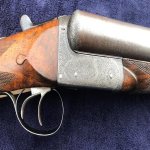
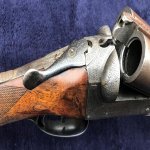
- A Stephen Grant 16 bore hammer gun, circa 1880. Very fine damascus and about the nicest walnut I’ve seen. 30" barrels, 6 lbs 1 oz.
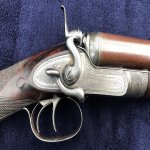
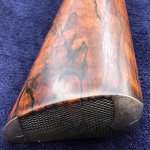
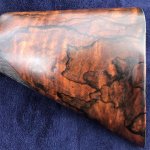
- A Dougall 'Lockfast' 16 bore double rifle (not actually a shotgun and the maker was Scottish, but it fits the theme here, I think). Late 1880's, 26" barrels with polygonal rifling, marked 'Highest Quality', 8 lbs. Lovely scroll engraving, 1 standing and 2 folding leaf sights to 150 yards.
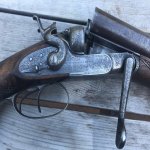
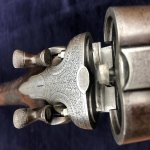
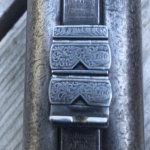
Cheers!
A couple of years ago, I inquired with https://frederickbeesley.co.uk/ about this gun's history. If I remember correctly, it was made around the turn of the century, and the original barrels were damascus. The 'new' steel barrels shown in the photo have the 1954 - 1989 Birmingham proof marks.
Here are a few photos of some of my English damascus-barrelled favourites:
- A J&W Tolley 12 bore game gun. The gun has a Westley Richards doll's head type fastener, Deeley ejectors, 28" barrels, 6 lbs 4 oz.


- A Stephen Grant 16 bore hammer gun, circa 1880. Very fine damascus and about the nicest walnut I’ve seen. 30" barrels, 6 lbs 1 oz.



- A Dougall 'Lockfast' 16 bore double rifle (not actually a shotgun and the maker was Scottish, but it fits the theme here, I think). Late 1880's, 26" barrels with polygonal rifling, marked 'Highest Quality', 8 lbs. Lovely scroll engraving, 1 standing and 2 folding leaf sights to 150 yards.



Cheers!
Attachments
-
 J&W Tolley.jpg95.1 KB · Views: 279
J&W Tolley.jpg95.1 KB · Views: 279 -
 Tolley action.jpg88.2 KB · Views: 281
Tolley action.jpg88.2 KB · Views: 281 -
 Grant action 2.jpg110.7 KB · Views: 282
Grant action 2.jpg110.7 KB · Views: 282 -
 Grant stock 2.jpg91.8 KB · Views: 279
Grant stock 2.jpg91.8 KB · Views: 279 -
 Grant stock 3.jpg107.8 KB · Views: 276
Grant stock 3.jpg107.8 KB · Views: 276 -
 Dougall action 2.jpg108 KB · Views: 279
Dougall action 2.jpg108 KB · Views: 279 -
 Dougall action.jpg68 KB · Views: 274
Dougall action.jpg68 KB · Views: 274 -
 Dougall leaf sights.jpg71.5 KB · Views: 279
Dougall leaf sights.jpg71.5 KB · Views: 279
Last edited:
the spank
CGN Ultra frequent flyer
- Location
- Planet Earth Wearing My Tinfoil Hat
Hello:
A couple of years ago, I inquired with https://frederickbeesley.co.uk/ about this gun's history. If I remember correctly, it was made around the turn of the century, and the original barrels were damascus. The 'new' steel barrels shown in the photo have the 1954 - 1989 Birmingham proof marks.
Here are a few photos of some of my English damascus-barrelled favourites:
- A J & W Tolley 12 bore game gun. The gun has a Westley Richards doll's head type fastener, Deeley ejectors, 28" barrels, 6 lbs 4 oz.
View attachment 566281
View attachment 566282
- A Stephen Grant 16 bore hammer gun, circa 1880. Very fine damascus and about the nicest walnut i've seen. 30" barrels, 6 lbs 1 oz.
View attachment 566283
View attachment 566284
View attachment 566285
- A Dougall 'Lockfast' 16 bore double rifle (not actually a shotgun and the maker was Scottish, but it fits the theme here I think). Late 1880's, 26" barrels with polygonal rifling, marked 'Highest Quality', 8 lbs. Lovely scroll engraving, 1 standing and 2 folding leaf sights to 150 yards.
View attachment 566298
View attachment 566299
View attachment 566301
Cheers!
16 bore double rifle? What weight and diameter of bullet does that throw? Have any pics of the cartridge it uses?






































































